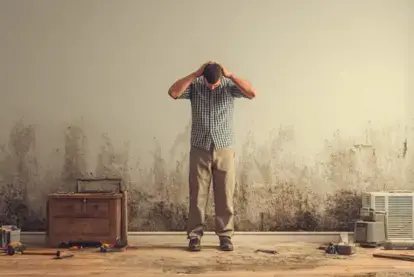
How to Get Rid of a Musty Smell in Your House
Contact COIT for a professional cleaning!
Nothing ruins a cozy home faster than a musty smell. It lingers in the air, clings to fabrics, and makes a space feel damp and unwelcoming. Beyond being unpleasant, a musty odor is often a red flag for excess moisture or mold — problems that can threaten both your home and your health.
Mold growth tends to weaken wood and cause it to rot, which is damaging to the structural integrity of your home and could be a costly fix down the line. Beyond this, mold is also harmful to breathe in, often causing people (especially those pre-disposed to respiratory issues) to experience allergic reactions, asthma, and skin irritation.
At COIT, we’ve been helping families tackle mold, odors, and indoor air issues for decades. In this guide, we’ll walk you through everything you need to know about identifying, removing, and preventing musty smells. You’ll learn quick fixes, deeper cleaning strategies, and long-term prevention tips, plus when it’s time to call in the professionals.
Why Does My House Smell Musty?
A musty smell is usually caused by mold and mildew growth. These fungi thrive in damp, poorly ventilated spaces and release microbial volatile organic compounds (MVOCs) that give off the familiar “old, damp” odor.
Common triggers include:
- High humidity indoors
- Poor ventilation (air that doesn’t circulate)
- Leaks in roofs, pipes, or appliances
- Damp basements, attics, or crawl spaces
- Wet carpets, upholstery, or clothing
- Water damage that wasn’t fully dried out
Did you know? According to the EPA, Americans spend about 90% of their time indoors, where pollutants — including mold spores — can be 2–5 times higher than outdoors. That makes indoor air quality a major health concern.
Why Does My House Smell Musty After Rain?
If you notice musty odors after a storm, water intrusion is often the culprit. Clogged gutters can push water into your walls, roof leaks may allow moisture to seep into the attic, and poor grading around your foundation can cause rainwater to collect and seep into the basement. After heavy rain, it’s important to inspect these areas closely, because unless the root cause is fixed, you’ll find yourself stuck in a cycle of recurring odors and potential damage.
Quick Fixes for Musty Smells
If you need the smell gone fast while you investigate the root cause, here are some quick and easy solutions:
- Air out the space
- Open windows and doors to create cross-ventilation.
- Use fans to push stale air outside.
- Set out odor absorbers
- Bowls of baking soda, vinegar, or activated charcoal work overnight to absorb odors.
- For a fresh touch, place cotton balls soaked in vanilla extract or lemon juice around the room.
- Run a dehumidifier
- Especially in basements or bathrooms, this lowers humidity and makes it harder for mold to grow.
- Wash soft surfaces
- Launder curtains, throw blankets, and pillow covers.
- Steam-clean carpets or schedule a professional carpet cleaning if smells linger.
These fixes will help clear the air temporarily, but to truly solve the problem, you need to find and address the source.
Finding the Source of the Musty Smell
Pinpointing where the musty smell originates is key. If the smell is relatively new, it might be coming from damp clothing or improperly dried laundry. Before investigating the various nooks and crannies of your home for potential leaks, consider inspecting your clothing and linens first. If the smell isn’t tied to any clothing or linens, you’ll want to inspect common areas of the house that are susceptible to mold and mildew growth such as bathrooms, attics, and basements.
Bathrooms
Mold thrives in warm, moist conditions. Because bathrooms tend to be more humid than other areas of the home due to consistent shower use, it’s important to monitor moisture levels. When it comes to bathrooms, mold can be found in a variety of places including within grout and tile lines, shower curtains, windows, sink and shower drains, shower mats, and in the toilet.
Attics
Heat rises, which means attics are often times the warmest area in the home. Not to mention, if your home is experiencing a roof leak, your attic will likely be the first area affected. Beyond excess moisture, attics are often made primarily of exposed wood, which is a feeding ground for mold.
Basements
While basements do experience some moisture and are often prone to flooding, they are also a popular source of mold growth because they are typically dark and, much like attics, are made of exposed wood. Most significantly, however, basement mold is likely the result of poor ventilation. When air cannot flow freely, it becomes stale and more susceptible to mold growth, which can lead to a musty smell.

How to Clean Mold and Mildew Safely
Once you’ve found mold, cleaning it properly is really important. The EPA recommends calling a professional if the affected area is larger than 10 square feet.
For smaller spots, here’s a safe DIY approach:
- Protect yourself
- Wear gloves, goggles, and a respirator mask.
- Ensure good ventilation while cleaning.
- Initial clean
- Mix dish detergent with warm water and scrub the surface with a sponge or brush.
- Dry the area completely.
- Disinfect
- Mix ¾ cup of bleach with 1 gallon of water.
- Apply to the moldy area and let sit for 5 minutes.
- Rinse with warm water and dry thoroughly.
- Dry thoroughly
- Use fans, air movers, or a dehumidifier to ensure no moisture lingers.
COIT Pro Tip: Mold thrives in damp environments and moisture control is just as important as cleaning. If you don’t remove the moisture, the smell will come back.
Contact COIT for a professional cleaning!
Commercial Mold Removers Vs. DIY Solutions
There are a few options available to remove mold and mildew in your home, and deciding whether to go with a commercial grade/store-bought option or a DIY solution can depend on where and how severe the mold growth is.
Oftentimes more convenient commercial-grade mold removers are stronger and can target more specific areas of the home or mold types. That said, because they are stronger, they do tend to include more chemicals, which can be harmful to breathe in.
On the other hand, homemade solutions tend to be more cost-efficient and can be made from ingredients you likely already own like bleach, vinegar, ammonia, etc, but thismay take a few tries to get right.
To best determine which to go with, consider the location of the mold. From there, do a bit of research to see which store-bought products or DIY solutions work best in that specific area of the home or on that particular surface.
How to Get Rid of Musty Smell in Basements
Basements are the most common musty trouble spots. Here’s how to tackle them:
- Use a dehumidifier to keep humidity under 50%.
- Seal cracks in foundation walls to prevent seepage.
- Install or maintain a sump pump to handle excess water.
- Store belongings in plastic bins instead of cardboard boxes.
- Schedule carpet or upholstery cleaning if soft materials are affected.
If odors persist despite these steps, it might be a sign of hidden mold inside walls or insulation, which is a job best left to professionals.
Natural Deodorizers That Actually Work
Many homeowners prefer natural methods before turning to chemicals and these options can neutralize musty odors:
- Baking soda: Absorbs odors from air and fabrics. Sprinkle on carpets before vacuuming.
- Vinegar: Breaks down smells in the air and on surfaces. Leave bowls out overnight or wipe down surfaces.
- Activated charcoal: Highly porous and excellent for absorbing moisture and smells.
- Essential oils: Tea tree oil and eucalyptus are natural antifungals. Add a few drops to a diffuser.
- Indoor plants: Snake plants, peace lilies, and pothos can improve air quality and reduce musty odors.
Improving Ventilation for Fresher Air
Stale air contributes to mold growth, so fresh air is your first line of defense against musty odors. Proper ventilation reduces humidity, circulates fresh air, and keeps mold spores from settling.
Benefits of Proper Ventilation
A well-ventilated home means healthier indoor air quality. We spend about 90% of our time indoors, which is why ensuring your home’s ventilation system works properly should be a top priority. Allergens, pollutants, dust, mold, and other harmful particulates are constantly carried into our homes and into the air we breathe. A properly functioning ventilation system moves the air around so it doesn’t become trapped in the home and instead makes its way outside.
Beyond healthier living, proper ventilation (i.e. ventilation that allows air to flow and circulate freely without blockages), can contribute to lower energy costs. A blocked system has to work extra hard to circulate air, and if dust and debris are left to collect over time, this can contribute to more costly energy bills and could become expensive to fix down the line.
Tips for better airflow
- Run bathroom and kitchen exhaust fans during and after use.
- Use ceiling fans to keep air moving.
- Crack windows for cross-ventilation when weather allows.
- Invest in a whole-home air purifier.
- Get your air ducts cleaned every 2-3 years.
Our professional air duct cleaning removes dust, mold spores, and debris that block airflow and cause odors. To schedule a professional air duct cleaning, contact COIT today.
Prevent Future Musty Smells
While we can’t always prevent a leak from happening in the first place, there are a few things we can do to prevent mold growth and musty smells in the home.
COIT’s Home Maintenance Checklist:
Inspect and repair roof leaks
Clean gutters twice a year
Replace HVAC filters every 3 months
Schedule air duct cleaning every 2–3 years
Wash curtains, upholstery, and rugs regularly
Store clothing and linens in breathable containers
Keep indoor humidity between 30–50%
Check basements, attics, and crawl spaces for dampness
For more preventative tips, see our maintenance checklist for homeowners below:

When to Call Professional Cleaning Services
Some musty smells are beyond DIY solutions. Call COIT if:
- Mold covers more than 10 square feet
- Odors persist despite cleaning and dehumidifying
- You find mold inside drywall, ceilings, or HVAC systems
- Flooding or water damage has occurred
- Musty smells trigger allergies or asthma in your household
Our team of certified technicians goes beyond just mask odors, we work to eliminate the source. From mold remediation to water damage restoration, carpet cleaning to air duct service, we’ll restore your home to a clean, healthy state.
Ready to Breathe Fresh Again?
Schedule a free consultation with COIT today. Whether it’s carpet cleaning, upholstery care, air duct cleaning, or full mold remediation, our experts are here to help you get rid of musty smells for good.



